China gold market update: Official holdings rose in July
13 August, 2025
Highlights
- Gold prices remained stable in July. Both the LBMA Gold Price PM in USD and the Shanghai Benchmark Gold Price PM (SHAUPM) in RMB ended last month with mild increases.
- Gold withdrawals from the Shanghai Gold Exchange (SGE) saw a mild seasonal m/m rebounded last month, yet remaining below the long-term average.
- Chinese gold ETFs saw outflows in July (-RMB2.4bn, -US$325mn) as investors’ risk appetite improved.
- Gold futures trading activity on the Shanghai Futures Exchange (SHFE) continued to cool in July but stayed elevated compared to previous years.
- China’s official gold reserves rose 2t in July, scoring the ninth consecutive monthly purchase, to 2,300t.
- Based on the latest data, China’s gold imports fell in June, concluding the weakest H1 since 2021.
Looking ahead
- We expect continued seasonal improvement in China’s wholesale gold demand going forward, particularly in the gold jewellery sector – although the affordability issue may keep volumes depressed.
- Meanwhile, the momentum in bar and coin demand will depend on factors such as the gold price trend and the overall risk appetite – the recent strong equity performance may divert some attention away.
Gold rose modestly in July
Gold prices continued to level off in July. Rising inflationary concerns and various other risks outweighed a stronger dollar, leading to a mild rise in gold prices: the LBMA Gold Price PM in USD was 0.3% higher m/m while the SHAUPM in RMB climbed 0.5%–due mainly to a weaker local currency against the dollar. And y-t-d, the RMB gold price has surged by over 22%, outperforming most local assets.
Chart 1: Gold kept levelling off in July
Monthly returns of the SHAUPM in RMB and the LBMA Gold Price PM in USD*
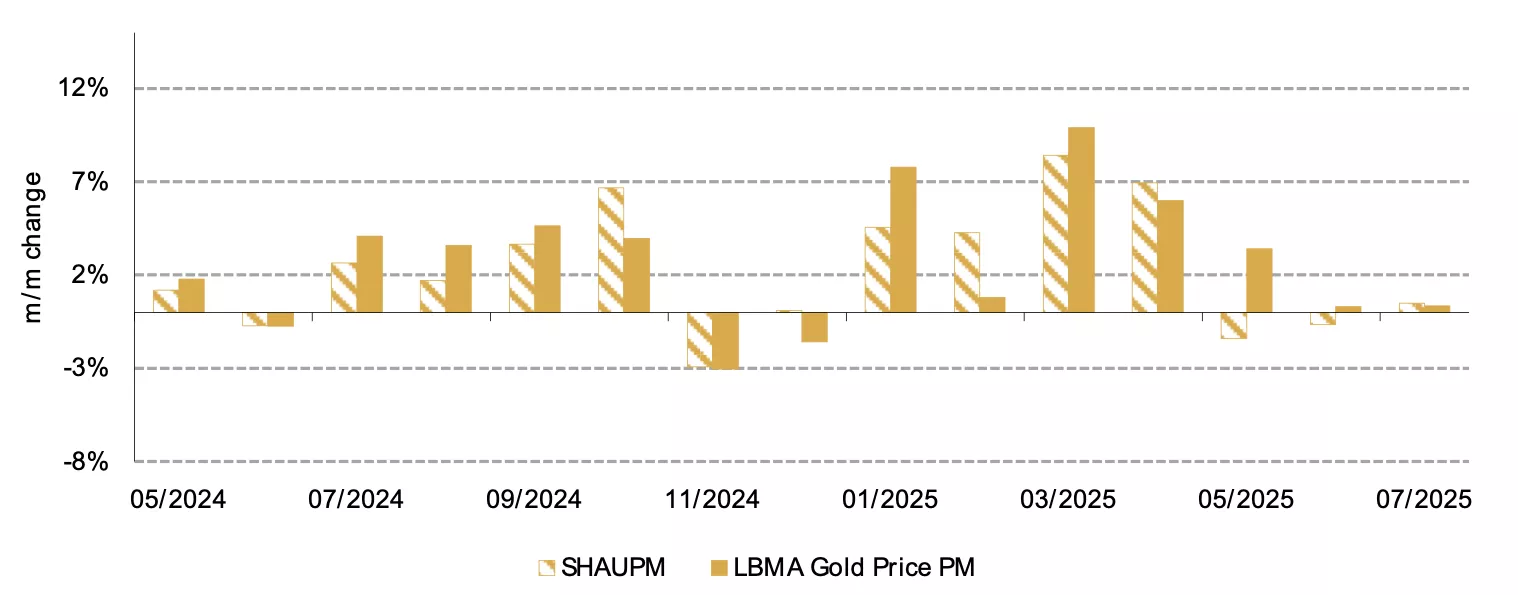
*Data as of 31 July 2025.
Source: Bloomberg, World Gold Council
Wholesale demand saw a minor m/m seasonal rise
Gold withdrawals from the SGE totalled 93t in July, a modest m/m rise of 3t and a slight increase of 4t y/y (Chart 2). As shown in the below chart, the m/m pick up is mainly seasonal: jewellery demand tends to improve into Q3. Meanwhile, we believe better sales of gold bullion – as physical gold investors took advantage of the current price stability – also contributed to wholesale gold demand’s rebound in July.
However, July’s demand was well below the 10-year average, highlighting wholesale gold demand’s weakness – particularly in the jewellery sector – this year. As we noted in our Q2 Gold Demand Trends, the divergence in China’s gold demand has continued amid the unprecedented level of the local gold price: while investment demand for gold kept surging, jewellery consumption – in tonnage terms – fell off a cliff, weighing on gold jewellers’ restocking activities – a major part of SGE withdrawals.
Chart 2: A mild m/m seasonal rebound in July’s wholesale gold demand*
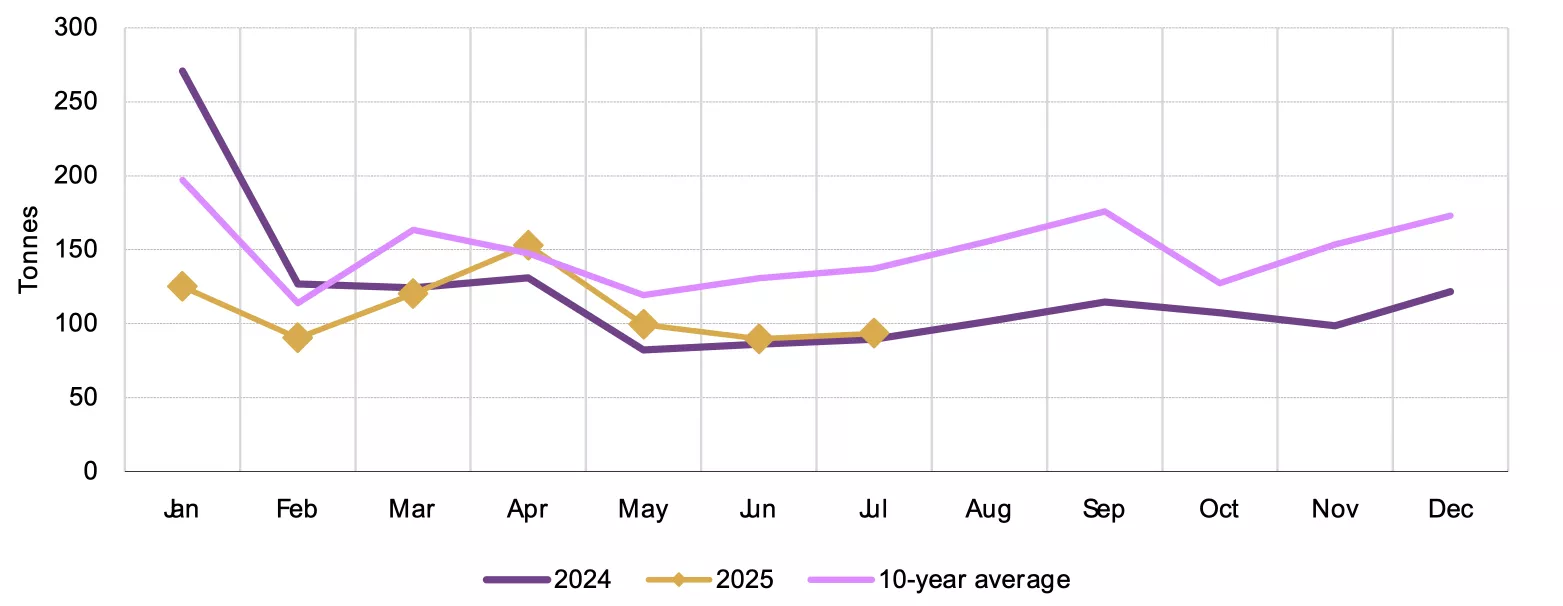
*The 10-year average is based on data between 2015 and 2024.
Source: Shanghai Gold Exchange, World Gold Council
Chinese gold ETF flows flipped negative again
Chinese gold ETFs saw outflows of RMB2.4bn (US$325mn) in July (Chart 3). Due to these outflows and a flat gold price, their total AUM declined slightly by 1% to RMB151bn (US$21bn). And collective holdings reduced by 3t to 197t. Despite the July loss, Chinese gold ETFs’ y-t-d inflows remained at a record high of RMB61bn (US$8.5bn, 82t).
With China’s Q2 GDP – released in mid-July – exceeding expectations, local investor risk appetite improved, which is reflected in the strongest monthly performance of the CSI300 stock index since last September. Meanwhile, local government bond yields kept rebounding amid the economic resilience and investors’ cooling expectations of further rate cuts from the People’s Bank of China (PBoC). These factors, combined with the lack of a clear trend in the local gold price, dimmed Chinese investors’ interest in gold ETFs during the month.
Chart 3: Chinese gold ETFs saw outflows in July
Collective holdings and monthly demand for Chinese gold ETFs*
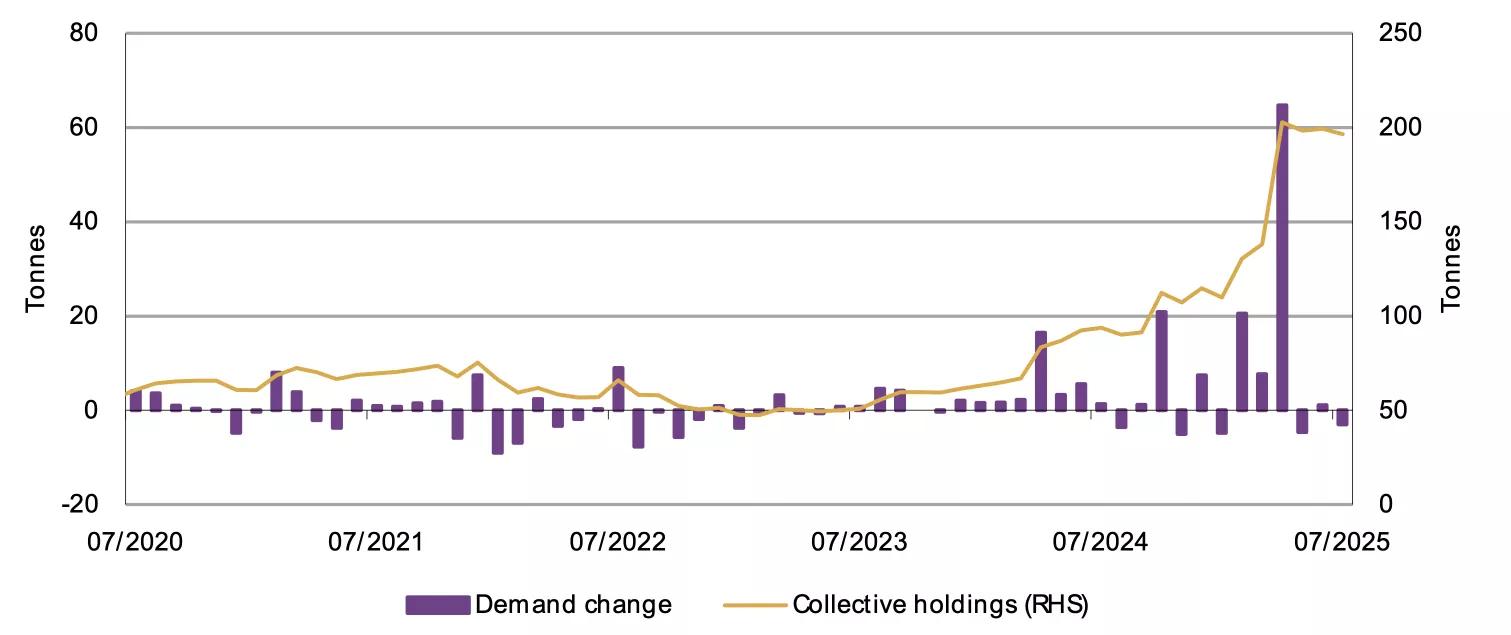
*As of 31 July 2025.
Source: Company filings, World Gold Council
Gold futures trading volumes at the SHFE averaged 242t/day, a 18% m/m fall yet remaining above the five-year average of 216t/day (Chart 4). We believe this drop is mainly related to the range-bound gold price performance and a declining price volatility during the month, which lowered traders’ interest.
Chart 4: SHFE gold futures’ trading volumes cooled in July
Monthly trading volumes of SHFE gold futures (daily averages)*
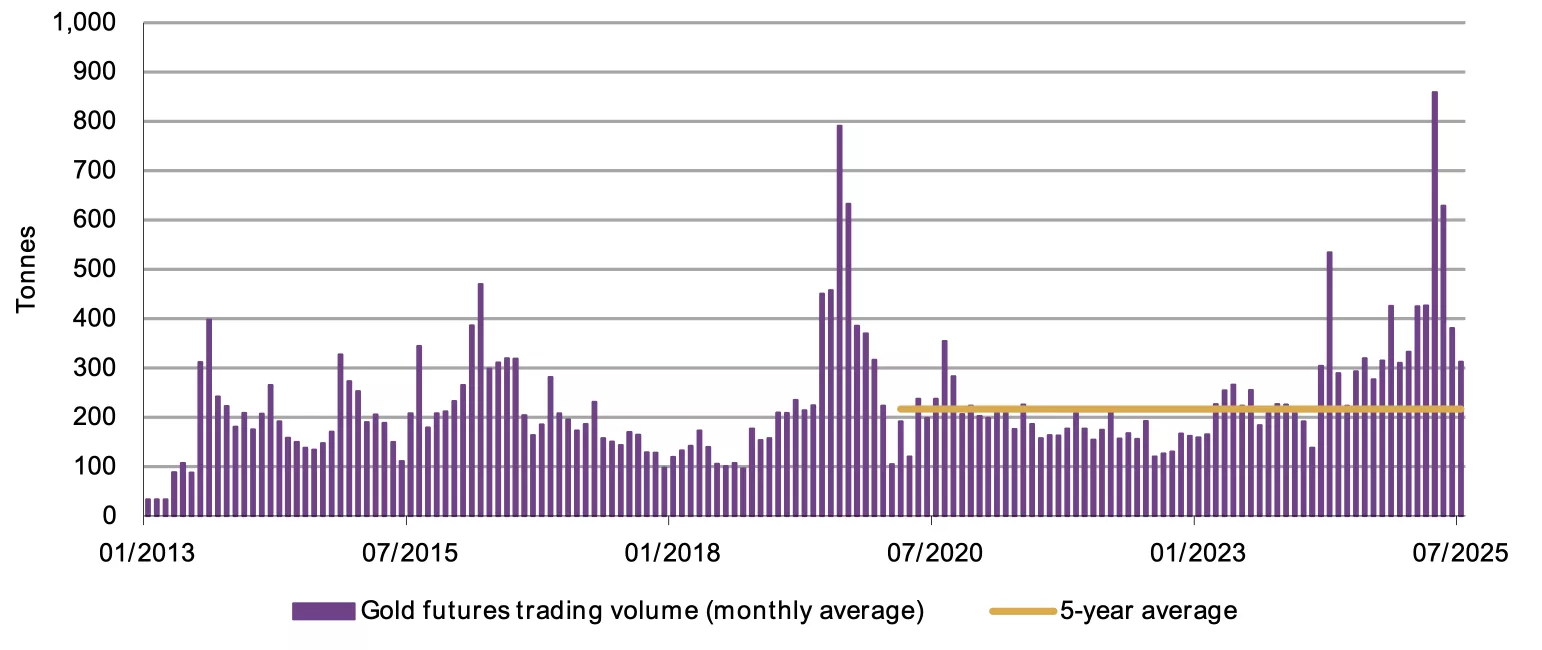
*As of 31 July 2025.
Source: Shanghai Futures Exchange, World Gold Council
The PBoC gold purchase streak extends to nine months
The PBoC announced another gold purchase in July, amounting to 2t, the ninth consecutive monthly addition. Following non-stop purchases during the past nine months, China’s official gold holdings now reached 2,300t, 6.8% of the total reserve (Chart 5). Y-t-d, China has increased its gold holdings by 21t.
Chart 5: The PBoC announced its ninth consecutive monthly gold purchase in July
Reported official gold holdings and gold as a percentage of total foreign exchange reserves*
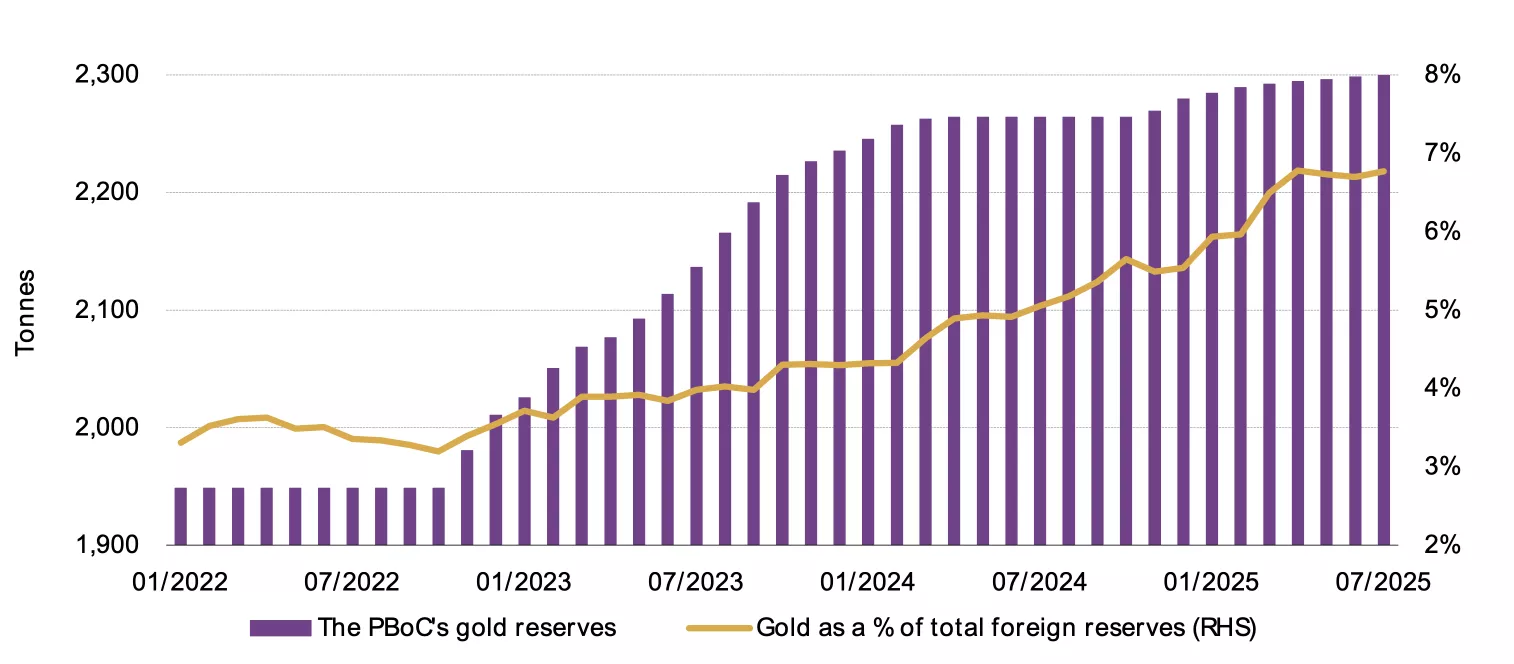
* As of 31 July 2025.
Source: State Administration of Foreign Exchange, World Gold Council
Imports weak in H1
China’s gold imports almost halved in June, totalling 50t, 45% lower m/m. We believe this is related to tepid wholesale gold demand in the month. And this takes the Q2 total to 250t, 18% below the 2024 level.
During the first half, China imported 323t of gold, a 62% plunge y/y. As we noted in the previous blog, China’s wholesale gold demand has weakened notably in H1. And this has likely suppressed the need to import.
Chart 6: H1 imports were low compared to previous years
Net 7108 gold imports under various regimes*
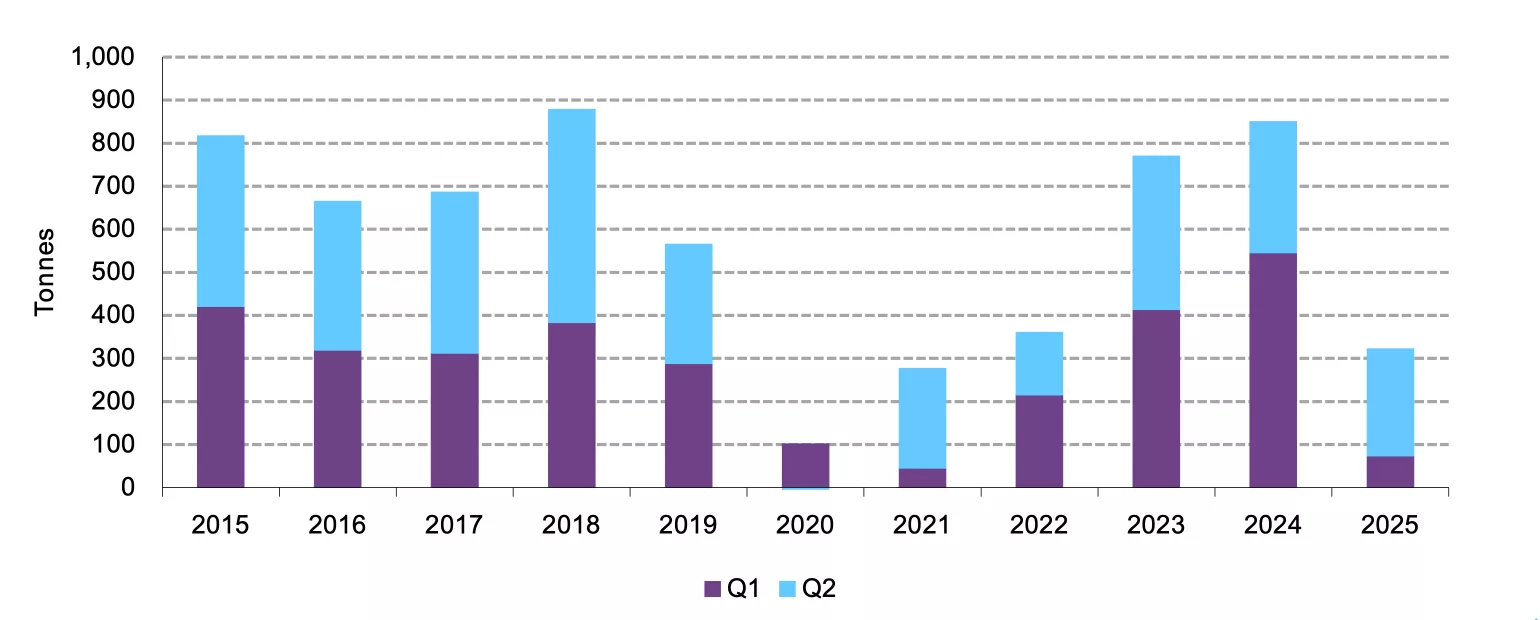
*Based on the latest data available. Data to June 2025.
Source: China Customs, World Gold Council
Disclaimer
Important information and disclaimers
© 2025 World Gold Council. All rights reserved. World Gold Council and the Circle device are trademarks of the World Gold Council or its affiliates.
All references to LBMA Gold Price are used with the permission of ICE Benchmark Administration Limited and have been provided for informational purposes only. ICE Benchmark Administration Limited accepts no liability or responsibility for the accuracy of the prices or the underlying product to which the prices may be referenced. Other content is the intellectual property of the respective third party and all rights are reserved to them.
Reproduction or redistribution of any of this information is expressly prohibited without the prior written consent of World Gold Council or the appropriate copyright owners, except as specifically provided below. Information and statistics are copyright © and/or other intellectual property of the World Gold Council or its affiliates or third-party providers identified herein. All rights of the respective owners are reserved.
The use of the statistics in this information is permitted for the purposes of review and commentary (including media commentary) in line with fair industry practice, subject to the following two pre-conditions: (i) only limited extracts of data or analysis be used; and (ii) any and all use of these statistics is accompanied by a citation to World Gold Council and, where appropriate, to Metals Focus or other identified copyright owners as their source. World Gold Council is affiliated with Metals Focus.
The World Gold Council and its affiliates do not guarantee the accuracy or completeness of any information nor accept responsibility for any losses or damages arising directly or indirectly from the use of this information.
This information is for educational purposes only and by receiving this information, you agree with its intended purpose. Nothing contained herein is intended to constitute a recommendation, investment advice, or offer for the purchase or sale of gold, any gold-related products or services or any other products, services, securities or financial instruments (collectively, “Services”). This information does not take into account any investment objectives, financial situation or particular needs of any particular person.
Diversification does not guarantee any investment returns and does not eliminate the risk of loss. Past performance is not necessarily indicative of future results. The resulting performance of any investment outcomes that can be generated through allocation to gold are hypothetical in nature, may not reflect actual investment results and are not guarantees of future results. The World Gold Council and its affiliates do not guarantee or warranty any calculations and models used in any hypothetical portfolios or any outcomes resulting from any such use. Investors should discuss their individual circumstances with their appropriate investment professionals before making any decision regarding any Services or investments.
This information may contain forward-looking statements, such as statements which use the words “believes”, “expects”, “may”, or “suggests”, or similar terminology, which are based on current expectations and are subject to change. Forward-looking statements involve a number of risks and uncertainties. There can be no assurance that any forward-looking statements will be achieved. World Gold Council and its affiliates assume no responsibility for updating any forward-looking statements.
Information regarding QaurumSM and the Gold Valuation Framework
Note that the resulting performance of various investment outcomes that can be generated through use of Qaurum, the Gold Valuation Framework and other information are hypothetical in nature, may not reflect actual investment results and are not guarantees of future results. Neither World Gold Council (including its affiliates) nor Oxford Economics provides any warranty or guarantee regarding the functionality of the tool, including without limitation any projections, estimates or calculations.
